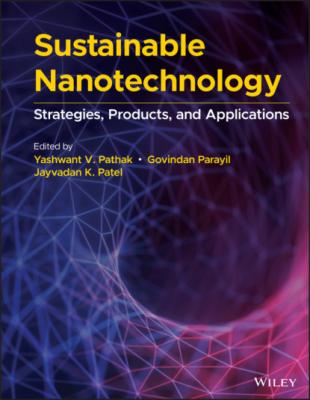Sustainable Nanotechnology. Группа авторов
Читать онлайн.| Название | Sustainable Nanotechnology |
|---|---|
| Автор произведения | Группа авторов |
| Жанр | |
| Серия | |
| Издательство | |
| Год выпуска | 0 |
| isbn | 9781119650317 |
There are many green synthesis protocols which use green chemistry principles for the preparation of nanoparticles and hence nanomaterials compared to conventional methods [103, 104]. This include
1 Nonhazardous naturally occurring materials to use as starting material using bottom‐up approach.
2 Recyclability and reuse of magnetic nanoparticles in nano‐catalysis applications.
3 Metal nanoparticles can be prepared using natural anti‐oxidant agents like polyphenols from Tea or wine or agricultural residues.
4 Nanoparticles prepared using mild reaction conditions in the facile synthesis display reduced toxicity and are suitable for environmental remediation applications.
5 Metal nanoparticles with antibacterial activities can be synthesized using biogenetic reduction by plants using reducing agents involved include various water‐soluble metabolite compounds.
6 Silver and gold nanoparticles which have applications in many industries are prepared using plant‐based green chemistry preparation principles.
7 Many crystalline inorganic compounds are prepared using bottom‐up low‐temperature methods such as hydro/solvothermal synthesis, template‐assisted approaches, nucleation, and growth in solution/suspension, microemulsion, miniemulsion, etc.
8 Microbial synthesis of nanoparticles using bacteria, fungi, and viruses; phototrophic eukaryotes, including plants, diatoms, and algae; heterotrophic human cell lines and some other biological agents fall under green synthesis of nanoparticles as eco‐friendly, cost‐effective, and simple approaches.
9 Microwave‐assisted organic synthesis methods are used to prepare metal nanoparticles.
Hence, nanostructures and nanocomposites of metals and metal oxides like, Au, Ag, Al, Eu, Co, Pd, Pt, Fe, C60, CdS, ZnO, Bi2O3, TiO2, NiFe2O4, etc. are prepared using bottom‐up methods like sol–gel method or chemical reduction methods using natural sources like plants, fungi, etc. These green chemistry preparation processes of nanomaterials and nanostructures boost the GNT movement and give confidence to industries to promote NT‐based products and services.
Table 3.4 Objectives of green nanotechnology in various areas of society.
| S. No. | Area | Objectives of green nanotechnology |
|---|---|---|
| 1 | Agriculture | To avoid environmental degradation in nanotechnology supported agricultural processes including pest control |
| 2 | Food processing | To eliminate poisonous contents in food and to avoid green gas emission and environmental degradation in all food packaging processes which are supported by green nanotechnology |
| 3 | Potable water | To develop large scale filters for water purification and seawater desalination through green nanotechnological processes without environmental degradation |
| 4 | Sustainable energy | To develop green nanotechnological processes for harvesting potential natural energy sources to generate required energy for human civilization without degrading environment |
| 5 | Consumer products | To produce a variety of new generation consumer products using green nanotechnology without side effects and without degrading environment in any manner during production, packaging, and in actual use by consumers |
| 6 | Automobiles | To produce energy efficient, zero emissions, durable automobiles using renewable energy processes based on green nanotechnology |
| 7 | Construction | To build environmentally friendly, energy efficient, smart buildings with the help of green nanotechnological processes |
| 8 | Industrial automation | To develop industrial processes which are environmentally friendly, no green gas emission, recyclable waste products using green nanotechnology |
| 9 | Computer and information communication | To develop and utilize environmentally friendly, recyclable electronic, and computer components which use renewable energy and efficient performance using green nanotechnology |
| 10 | Education | Use of green nanotechnology in all hardware required in education services |
| 11 | Health | Use of green nanotechnology with green processes in all health and medical services |
| 12 | Aircraft and space travel | Use of green energy and green nanomaterials and environmentally friendly nanotechnological processes in air and space travel |
3.9 Green Nanotechnology in Primary Industry Sector
The primary industry sector in the economy includes all industries that are involved in the production and extraction of raw materials from nature such as farming, mining, oil and natural gas, forestry, fishing, etc. The primary industry sector constitutes a larger portion of the economy in the entire world with more contributions from developing countries. GNT principles and processes have immense advantages and benefits in the primary industry sector compared to its constraints. Table 3.5 lists opportunities and challenges for GNT‐based innovations in the primary industry sector.
